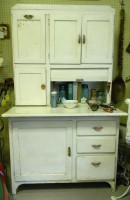Home Guru: About the Kitchen Pantry: The Most Practical Room in the House

Bill Primavera photo
By Bill Primavera
As I opened the door to my kitchen pantry to grab a quick snack, the thought occurred to me that I’ve lived in homes and apartments that didn’t feature a pantry and wondered how I managed without one.
As a kid, I distinctly remember how happy my mother was when she and my dad were able to purchase an older home that featured a “butler’s pantry,” which we hadn’t had before. To me, it sounded like something that only a fancy home should have.
A pantry might be as small as a shelf in a cupboard or as large as a walk-in closet. It is where we keep the foods and supplies used most often. This also is where small appliances will most likely be used such as the toaster, kettle, mixer, juicer and coffee machine. In my case, I also squeeze in a dry mop standing to one side and a small canister vacuum cleaner on the floor under the bottom shelf.
Being naturally curious about the origin of things, I also wondered how the pantry came about. The history of kitchen storage is an interesting reflection of what was going on through the ages socially, economically and, today, architecturally.
The word “pantry” comes from the French word paneterie, meaning from “pain,” the French word for bread. In medieval times food and supplies were stored in a number of specific rooms. Meats were kept in a larder, alcohol stored in a buttery and bread was stored in the pantry.
In Europe, traditionally the butler’s pantry was used to store silver, serving pieces and other kitchen-related items. Because of its value, silver was kept under lock and key with the butler actually sleeping in the pantry to guard against thievery.
In America, pantries evolved from early American “butteries,” built in a cold north corner of a home, into a variety of pantries in self-sufficient farmsteads. A cold pantry was the place to keep foods that did not necessarily need to be kept refrigerated. Breads, pie, cheesecakes, pastries, eggs and butter were common foods kept in a cold pantry. Vegetables could be brought up from the root cellar and stored in the cold pantry until ready to use.
Prior to World War II, smaller homes in America did not have closets, cabinets or pantries for food and kitchen storage. To fill the need for kitchen storage, in the early 1900s the Hoosier Cabinet, made by the Hoosier Manufacturing Co. in Indiana, was created to be an all-in-one pantry for the new American home. Most Hoosier cabinets were about six feet high, four feet wide and two feet deep, making it ideal for small kitchens. The cabinet was typically sold with built-in storage bins and containers for everyday items like flour, sugar, coffee, tea and household spices.
Hoosier cabinets today are found mostly on eBay, but for those that don’t have a pantry, there are tall pantry-type cabinets that go from floor to near the ceiling. These cabinets can store a lot of items, particularly if they are equipped with pullout can racks, shelving on the back of the doors and built-in bins.
Whether a home features an elaborate pantry room or just designated shelves in kitchen cabinetry, there are now so many storage gadgets and devices that can make available space go much further. Lazy Susans help with access to items that would normally be stored in the back of a shelf. Pullout shelves accomplish the same goal. Bins can help keep loose items together and organized.
Because some things stored in pantries can be quite small, a pantry can be enhanced with a few smaller containers or drawers for loose items. Also, there can be mini shelves or racks for spices that can be added to the back of the pantry door. Of course, pantries are good places to store bulkier items, like paper towels and plastic storage containers.
In today’s homes, butler pantries can serve as an “in between room” located between the kitchen and formal dining room. Typically you will also find countertop space to be used as staging areas for serving meals, as well as storage for tableware, serving pieces, table linens, candles, wine and other dining room articles. More elaborate versions may include refrigerators, sinks or even dishwashers.
If the kitchen is regarded as the “heart” of the house, then certainly the pantry is its blood supply.
Bill Primavera is a Realtor® associated with William Raveis Real Estate and Founder of Primavera Public Relations, Inc., the longest running public relations agency in Westchester (www.PrimaveraPR.com). His real estate site is www.PrimaveraRealEstate.com, and his blog is www.TheHomeGuru.com. To engage the services of The Home Guru to market your home for sale, call 914-522-2076.

Examiner Media – Keeping you informed with professionally-reported local news, features, and sports coverage.


